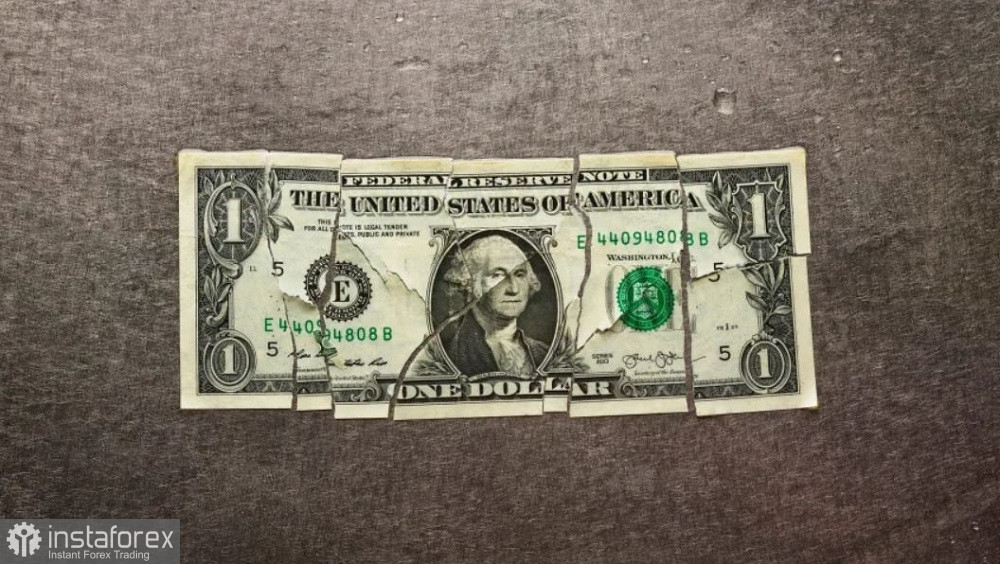US inflation is slowing, yet the dollar is rising. An anomaly? Both yes and no.
On one hand, the current rise of the US dollar across the market appears illogical. All components of the two most important inflation reports (CPI and PPI) were in the "red zone," reflecting a slowdown in inflation in May. The core PCE index, although it has remained at the same level (2.8%) for three consecutive months, is at a three-year low (the lowest level since March 2021). The only pro-inflation indicator favoring the greenback was the Nonfarm Payrolls report, which showed an acceleration in wage growth (4.1% versus the forecast of 3.9%).
On the other hand, the rise of the dollar seems quite logical, considering the outcomes of the June FOMC meeting. The updated dot plot has redrawn the fundamental picture for all dollar pairs, including EUR/USD. Now, inflation reports are viewed through the lens of the updated dot plot.

To recap, following the June meeting, the US Federal Reserve adopted a wait-and-see approach. However, the Fed did not provide clear guidance on the timing of the first interest rate cut. Jerome Powell stated at the press conference, "I don't know when we will begin easing policy." The accompanying statement did not help traders either. The overall message was that the Fed intends to lower the interest rate, but only when it is confident that inflation is moving sustainably towards the 2% target. No additional clues were provided. The Fed noted some progress in the fight against inflation (previously, it stated there was no progress), but more is needed for practical conclusions.
In other words, the Fed communicated a very ambiguous stance on the timing of the first rate cut.
However, the dot plot was a sensation. The updated forecast now suggests only one rate cut of 25 basis points by the end of this year. In March, 10 out of 19 Fed members expected three rate cuts in 2024 totaling 75 points. One member even anticipated a 100-point cut this year.
Clearly, the Fed's doves have significantly tempered their expectations. The ambitious 75-point cut has been reduced to 25 points. According to Jerome Powell's rhetoric, the Fed cannot provide clear guidance on the timing of the first (and only) rate cut. The vague statement that the Fed will begin easing monetary policy when it is confident in a sustained decrease in inflation leaves more questions than answers. For example, CPI has been decreasing for two consecutive months, and PPI also came in the "red zone" (the overall producer price index slowed to 2.2% year-over-year, and core PPI slowed to 2.3% in May from 2.5%). Yet, the Fed maintains a "moderately hawkish" stance, insisting that inflation is still too high and its deceleration is insufficient.
Essentially, dollar bulls need not worry about the decline in key inflation indicators. Even if the current pace persists, the Fed is likely to opt for only one rate cut, either in the fall or December. The market has already partially priced in a rate cut for September, as traders have been estimating a 50/50 chance since mid-spring. For example, the probability of easing monetary policy at the September meeting has risen to 67% (according to the CME FedWatch Tool). However, the greenback remains strong: the US dollar index has returned to the 105 level, and the EUR/USD pair has hit a 1.5-month low, currently attempting to stabilize around the 1.06 level.
This indicates that the dollar has essentially priced in a rate cut this year. Hints of a possible September (or December) decision no longer pressure the greenback, nor do dovish signals such as slowing inflation.
The dollar is also supported by a significant (and unexpected) revision of the pace of monetary policy easing. At the beginning of the year, the Fed was prepared for three rate cuts. Now, those plans have been narrowed down to one round in the remaining half of the year.
In fact, the US Fed has adopted a tougher stance compared to the European Central Bank, the Swiss National Bank, and the Bank of Canada, which have already begun easing monetary policy (the Bank of England is rumored to be preparing for a rate cut this month). In this environment, the greenback has increased in demand.
Politics also provides additional support for sellers of the EUR/USD pair. The European Parliament election results, the overall rise of right-wing and far-right forces in Europe, and the upcoming French parliamentary elections (with the prospect of a subsequent political crisis) all put pressure on the euro and, consequently, on EUR/USD.
From a technical standpoint, the pair is either at the lower or between the middle and lower lines of the Bollinger Bands indicator on the H4, D1, and W1 timeframes and below all lines of the Ichimoku indicator. The nearest price barrier (southern movement target) is at the 1.0640 level (the lower Bollinger Bands line on the weekly chart).
 English
English 
 Русский
Русский Bahasa Indonesia
Bahasa Indonesia Bahasa Malay
Bahasa Malay ไทย
ไทย Español
Español Deutsch
Deutsch Български
Български Français
Français Tiếng Việt
Tiếng Việt 中文
中文 বাংলা
বাংলা हिन्दी
हिन्दी Čeština
Čeština Українська
Українська Română
Română

